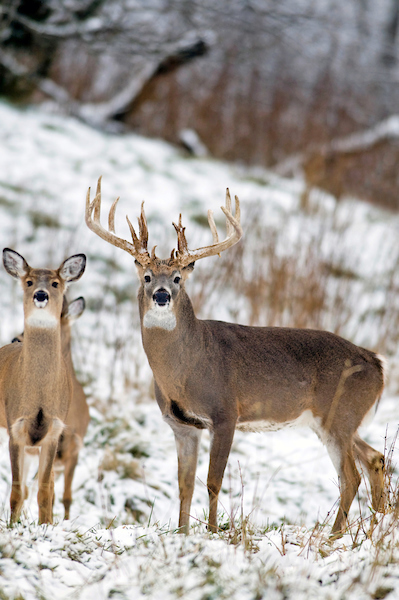It’s not just cold out. The snow has been falling all night. By the time it ends there is more than a foot of it on the ground. This is truly a harsh winter.
You think, “What about the deer?” What little food remains is buried under all that snow. Those deer are surely starving. Racked with guilt, you run to the farm supply store. You load up on bagged corn and pour it out along the field edges around your property. In a matter of a few days, deer line up along the wooded edge as they await another delivery of corn. You gladly give them. You feel like a hero.
Deer Can Survive Without You
Turns out, you’re not actually a hero. In fact, you may have just sentenced those deer to a slow, agonizing death. That's how Quality Deer Management Association (QDMA) outreach director Kip Adams explains it. A sudden change in diet, no matter how nutritious or plentiful, can actually kill deer.
“It can really be a shock to their system. I’ve seen numerous instances where a new source of food in the winter has actually killed deer,” he says.
Biologists agree. The simplest solution to a harsh winter is to allow nature to take its course. No one likes to see starving deer. No hunter wants to see frozen carcasses scattered about. That sometimes happens, though.
Winter-kills are no different and no less natural than a hunter killing a deer.
The good news is that while some deer may die, many won’t. That’s how nature works. Whitetails in particular have evolved so that enough survive the harshest conditions to rebuild their numbers in following years.
“Deer are programmed to go though a sort of controlled starvation,” says Maine Department of Inland Fisheries and Wildlife (IFW) deer specialist Kyle Ravana. “Studies have shown that even with abundant, high-quality food, deer will actually continue to lose weight throughout winter.”
Feeding deer comes with myriad problems, says Adams. It concentrates a high number of them in a small area. That can lead to disease transmission, higher rates of predation and unnatural pressure on the surrounding habitat. In fact, studies have shown that predators can actually take more deer around feed sites than the elements take in a more natural situation. Worse, it creates a never-ending cycle of dependency that builds throughout the season. As more deer learn of the handout, they too congregate around the feeding site. This gives you even more mouths to feed as more deer pack into a small area. They become accustomed to humans, as well, which can lead to poaching and other problems.
“When I was the deer program leader for New Hampshire Fish and Game, we would walk deer yards to monitor populations and the habitat. We pretty much always found more dead deer around areas where they were being fed than around areas where they weren’t being fed,” Ravana says. “Either they were killed by coyotes or stray dogs or they got hit by cars because they were being fed close to a road or they died of problems related to the feed.”
The absolute worst thing you can do is start feeding deer when the most severe winter weather sets in. That leads to a sort of shock to their digestive system. As Ravana says, the rapid abundance of food is unnatural, particularly if it’s something like corn or hay, which offers virtually no nutritional benefit to whitetails.
Should You Still Help During The Winter Anyway?
There’s no question the sight of hungry deer standing in the backyard can be heart-wrenching. That’s why some hunters and wildlife watchers simply can’t refuse to feed, no matter how much evidence shows the harm it can do.
The good news? Some studies have shown feeding can actually boost deer survival rates. With that said, it has to be done properly, timely and with the right types of food. Adams says corn can actually be beneficial. “It’s relatively low in nutritional value, but it’s high in energy. They can benefit from it,” he says.
Ravana, however, suggests something like pelleted horse or deer feed, which contains high levels of protein and fiber. “Ideally, you want to start early in the season so deer get used to it. They eat corn as soon as it is available in the fall through when it is all consumed later in the winter in places like Iowa, so there is little risk of shock in that situation, but starting it in the worst part of winter is a very bad thing to do,” he adds.
Feeding deer in southern states is a complete waste of resources, agree Ravana and Adams. Food is not a limiting factor, even during the shortest, coldest days of winter, and there is virtually no risk of starvation or any other impact from a southern January. In fact, Adams says the risk of winter kill is minimal south of the northern Pennsylvania border. Only in the most extreme cases will deer succumb to the elements in the south or even in places like Kentucky, Oklahoma and Missouri. And when they do, it usually has nothing to do with a lack of food.
“A deer can go a pretty long time without eating, especially if they are in good health going into the winter,” says Adams.
With that said, no matter where you live, it’s important to offer food well before you think they need it. As Adams said, it can take weeks for a deer’s digestive system to get used to a rapid change in diet, particularly when they aren’t eating much to begin with. He suggests starting a feeding program long before severe weather sets in. (Check your state’s regulations. Feeding and/or baiting are illegal in many states or during certain times of the year.)
There is some disagreement on how to properly feed deer, though. Some experts recommend putting feed in troughs to prevent it from becoming wet, which can result in moldy or even toxic food. However, placing feed in troughs forces deer to eat from the same small area, which can increase the risk of disease transmission. Others suggest broadcasting it across a wide area on dry ground to prevent deer from repeatedly sticking their noses in the same spot. Just consider your conditions when you feed.
The Best Solution For Winter
No one will disagree that buying bag upon bag of protein pellets for two or three months is expensive, though. The good news is there’s a better alternative, and it’s one that not only helps your deer make it through winter, but they’ll flourish during the spring, summer and fall. The alternative involves a chainsaw, maybe a tractor and some seed, fertilizer and lime.
“Improve the habitat. That’s going to be better for the deer in the long-run and it will ultimately be less expensive than a feeding program,” says Adams. “The better shape deer are going into the winter, the better their chances of surviving. The idea is to help them build up body fat in the summer and fall so they can live off it throughout the winter.”
Habitat improvements can include a variety of things, including food plots and fallow field conversion.
Although food plots do provide abundant forage during certain times of the year, they may not last deep enough into the winter to help. Thinning your forest, however, can create a whole new long-term source of food. The new growth that springs up from the ground once sunlight reaches it will provide an abundance of buds and other browse when it’s needed the most. Even better, it will be up off the ground instead of under two feet of snow.
Don’t cut all your trees, though, especially if you live in northern states. Deer need the protection provided by dense stands of evergreens like cedar, fir and spruce trees. They catch snow on their boughs. These deer yards, as they are called, serve as winter-long refuges where deer congregate and wait out the toughest conditions.
A late-season food plot consisting of something like rape or turnips can provide good forage, but unless it covers several acres, it won’t provide enough food for winter. Of course, that depends entirely on your deer densities, says Adams, but a food plot is a better use of limited resources than bags of corn or protein pellets.
“It doesn’t necessarily have to last all winter,” he adds. “Remember, deer evolved to survive some pretty harsh winters. They are a lot tougher than we often give them credit for.”
If you really care about them, says Adams, you won’t feed them at all.







